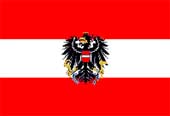 |
Number of versions: 30
Edition: February 16, 2010
|

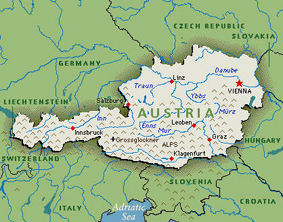 Shortly after the introduction of Monopoly games in 1935 in the USA
by Parker Brothers the first inland made Monopoly-like games were introduced on the Austrian market
as Business, Konjunktur and Spekulation. However, these games finally changed into
Das Kaufmännische Talent (DKT) at the outset of WW II and the name never changed again. Shortly after the introduction of Monopoly games in 1935 in the USA
by Parker Brothers the first inland made Monopoly-like games were introduced on the Austrian market
as Business, Konjunktur and Spekulation. However, these games finally changed into
Das Kaufmännische Talent (DKT) at the outset of WW II and the name never changed again.
From 1936 till 1990 the DKT editions and its
precursors have been published by
Stomo Spiele, but it became very restless
afterwards around these editions of inland manufacture, very likely because of
the rise of Hasbro.
From 1990 till the bankruptcy of its parent company in 2004 the
games were published by Peri Spiele and from 2005 till 2007
by the company
Freyspiel. In 2007 the company Brevillier
- Urban has yet published 3 editions, but since 2008 it is the
company Piatnik (again?) who makes them.
The Parker Brothers/Hasbro editions entered the Austrian market not untill about the
1980's.
(It turns out monopoly-like games of inland make to be in a
number of countries all over the world, mostly better known than the Parker
Brothers/Hasbro edition, also available since second half of the 20th century,
next to the inland versions. Except for Austria the countries are:
| * Argentina: Estanciero |
* Mexico: Turista |
| * Brasil: Banco Imobilíario |
* Norway: Millionær |
| * Denmark: Matador |
* Russia: Manager |
| * Hungary: Capitaly |
* Spain: El Palé) |
The 8 cities, stations and other spaces in all standard DKT
games are:
Bregenz: Arlbergstrasse (39) -
Rathausstrasse (40) - Start (1) - Amtsplatz (2) - Chance (3) - elektr. Kraftzentrale (4)
Graz: Murplatz (5) - Annenstrasse (6) -
Joaneumring (7) - Eisenbahn Wien-Graz
(8) - Sparkassa (9)
Eisenstadt: Jos. Haydngasse (10) - Gesetzes-§Verletzung
(Law-section Injury)
(11) - Schlossgrund (12) - Donau-Dampf-Schiffahrt Wien-Budapest (13) - Sender (14)
Wien: Kärntnerstrasse (15) -
Mariahilferstrasse (16) - Koblenzstrasse (17) - Elektr.Bahn Wien- Innsbruck
(18)
Linz: Landstrasse (19) - Stifterstrasse (20)
- Vermögensabgabe (property-tax) 10% höchstens 350.- (21)
- Museumstrasse (22) - Chance
(23) - Autobuslinie Glocknerstrasse (24)
Salzburg: Mirabellplatz
(25) - Westbahnstrasse (26) - Universitätsplatz (27) - Sparkassa (28)
Klagenfurt: Burggasse (29) -
Villacherstrasse (30) - Zelle 3 (Jail)
(31) - Alter Platz (32) - Erwerbsteur 80.- (33) -
Fluglinie Wien-Venedig
(34)
Innsbruck: Maria Theresienstrasse (35) -
Andreas Hofer-Strasse (36) - Boznerplatz (37) - Chance (38)
After ±1955 space (14) changed from Sender into Seilbahn.
Late 20th century Chance and Sparkassa were changed into Risiko
and Bank.
The 8 cities, stations and other spaces in all standard Parker
Brothers/Hasbro games are:
Eisenstadt: Eszterhazystrasse - Gemeinschafts-feld
(Community space) -
Schlosspark
- Einkommensteuer - Südbahnhof
Graz: Grieskai
- Ereignis-feld (Event space) - Herrengasse - Schlossberg
- Im Gefängnis/Nu zum Besuch
Linz: Wiener Strasse - Elektrizitätswerk - Bismarckstrasse -
Mozartstrasse - Westbahnhof
Klagenfurt: Beethovenstrasse - Gemeinschafts-
feld - St. Veiter Strasse - Viktringer Ring - Frei Parken
Salzburg: Ignaz-Harrer-Strasse - Ereignis-feld -
Auerspergstrasse - Hellbrunner Strasse - Nordbahnhof
Innsbruck:
Salurner Strasse - Herzog-Otto-Strasse - Wasserwerk - Kaiserjäger Strasse - Gehe in das Gefängnis
Wien: Opernring - Hoher Markt - Gemeinschafts-feld -
Graben - Franz-Josef Bahnhof
Bregenz: Ereignis-feld - Römer Strasse
- Luxussteuer - Rheinstrasse
The 5 essential differences between DKT and Monopoly
are:
- In Monopoly a property can be mortgaged, in DKT not.
- The property prices are not mentioned on the game board with DKT.
- The Jail is at the first corner after Los in Monopoly but at
the third corner in DKT (Zelle 3). That is why there is an
instruction in DKT
saying: A player leaving or on his way to Jail do not receive 200.- at
Start.
- Instead of Free Parking in Monopoly one have to pay up to 10% Fortune
Tax at that corner with DKT.
- There are only 8 houses, whereas Parker Brothers Monopoly has 12.
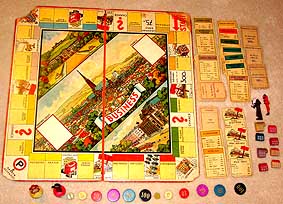 Edition:
Business (- Vienna) - long red box Edition:
Business (- Vienna) - long red box
Ges.Gesch. (Protected by law)
Publisher: Schowanek - ±1936
Dimensions of the box: 50.3 x 39.5 x 3.8
cm
of the board: 48.8 x 49.2 cm
The game:
This game is from the collection of Phil Orbanes - USA.
Phil could tell about this set as he got it:
"I contacted its prior owner and learned that his mother had received it in 1936 (likely) or perhaps 1937 in Vienna.
The game was sold by a man whose mother hand-carried it out of Vienna after the Nazis annexed Austria (her parents
thought it best to flee to the US). He remembered playing it with his parents when he was young.
The long box was
lost long ago, and no manufacturer's name appears anywhere on the board or cards."
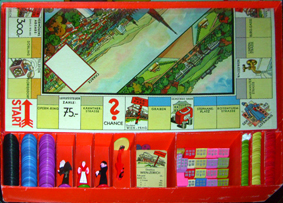 A
few years later Roland
Klose - D also obtained a copy of this early Austrian game in an
even better condition and being exactly the same in all details. This fact
therefore proves all those wooden accessories like the: A
few years later Roland
Klose - D also obtained a copy of this early Austrian game in an
even better condition and being exactly the same in all details. This fact
therefore proves all those wooden accessories like the:
 |
300 money discs, |
 |
4 very special tokens on a round foot, |
 |
houses and hotels
painted in various colors |
to be original and made by Schowanek, a wood turner
company.
 On the other hand this Monopoly version
resembles that much the
Parker Brothers' design that Mr. Hans Schowanek must have been aware
of its exsistance! On the other hand this Monopoly version
resembles that much the
Parker Brothers' design that Mr. Hans Schowanek must have been aware
of its exsistance!
He copied a lot like:
 |
8 groups of 3 properties each, although the prices of these
properties are not mentioned on the game board.
Neighter do the colorbars of the groups correspond those of Parker Bros. |
 |
the tax space "Pay 10% or 300.-" 4 steps after
Start. |
 |
the Jail corner, however not with a rascal behind bars, but
the inside of a cell, showing the year 1927. |
 |
the next corner being a Free Parking space ("Parken
gestattet"), but showing a No Parking-sign. |
 |
the Go to Jail ("Geh ins Gefängnis") corner. |
 |
a Luxury tax space between the most expensive streets. |
 |
4 station spaces situated in the middle of each side. |
 |
Chance- and Gemeinde-Kasse (Community chest)
cards, in addition to which their spaces on the board are also
situated opposite Start and the Free Parking corner. |
Since the manufacturer claims a "Ges.Gesch."(Gesetzlich Geschützt = Protected by
Law) negotiations with Parker Brothers may have taken place in this
very early stage?
The red box is broader than usual because
the folded game board, playing side outwards, is situated in the innerbox next
to the trays for all accessories instead of on top.
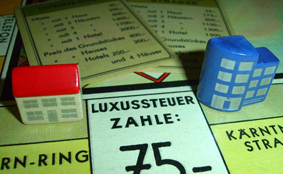 From Start on all spaces are districs,
streets and a palace in Vienna: From Start on all spaces are districs,
streets and a palace in Vienna:
Floridsdorf - Telefon - Döbling - Vermögens Abgabe:
zahle 10% oder 300,- - Wien-Zürich
- Rennweg - Chance - Wiedner Haubtstrasse -
Gudrunstrasse - Gefängnis
- Schönbrunn - Elektrizitätswerk
- Hietzing - Breitensee
- Wien-Rom -Taborstrasse
- Gemeinde-Kasse - Prater
- Augarten
- Parken gestattet - Schottenring -
Chance - Alser-Strasse - Wahringer-Strasse
- Wien-Bukarest - Burg-Gasse - Linden-Strasse
- Wasserwerk - Mariahilfer Strasse
- Geh ins Gefängnis(Go to Jail) - Rotenturm-Strasse
- Stephans-Platz - Gemeinde-Kasse - Graben
- Wien-Prag - Chance - Kärntner-Strasse
- Luxussteuer zahle: 75.- and Opern-Ring.
The central part of the game board shows 3 pictures, resp. Sissie's
Schönbrunn palace - Stephan's
Dom and Die
Wiener Staatsoper.
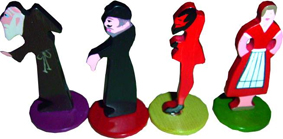 There is a third utility, viz. the Telephone, a
fenomenon unknown by Parker Brothers. There is a third utility, viz. the Telephone, a
fenomenon unknown by Parker Brothers.
The design of the property cards (48 x 63 mm) look very familiar to
that
we know from
Parker Brothers but because the properties can not be mortgaged the
backside of the deeds are empty.
The sizes of the blue Chance- and
maroon Gemeinde-Kasse
cards are 42 x 60 mm. They are made of white cardboard.
The money consist of 300 colored wood coins of 2 mm thickness in different
diameters in 6 denominations: 1 - 5
- 10 - 20
- 50 and 100.
The 4 funny tokens perhaps depict figures from Austrian fairy tales?
There are only 15 houses
and 5 nicely painted hotels in different colors.
The rent of the unbuilt property of the last street from the
group before the "Go back to Jail" corner, the Mariahilfer Strasse,
is slightly
more expensive than that of the other 2 streets. So this means the mistake
made by Parker Brothers has not been copied.
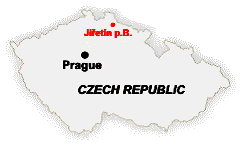 About the Schowanek company: About the Schowanek company:
 Johann Schowanek, a Czech wood turner and merchant, set up a company in 1896. In 1907
he moved to Jiretín where the company grew quickly. Starting off with wooden beads
and buttons, the production extended to include building blocks, games, toys
and models from 1927 on.
Johann Schowanek, a Czech wood turner and merchant, set up a company in 1896. In 1907
he moved to Jiretín where the company grew quickly. Starting off with wooden beads
and buttons, the production extended to include building blocks, games, toys
and models from 1927 on.
In 1935 Schowanek employed more than 1300 people. The boom was broken by the
World War II when the production program obtained an army character.
Jiretín
is located in the Iser Mountains close to the Polish and German border,
and in Schowanek's days most of the population in this area spoke German (the
town was then better known by its German name Georgenthal/Albrechtsdorf).
After Mr. Johann Schowanek's death in 1934 the
companies management took his son Hans in, who headed the company until May,
1945, the year his company was confiscated and Hans was transported by the
Russians. He was soon liberated by friends who brought him to Austria where he
started a new company in Salzburg.
From 1950s, his original company has been known as ToFa Albrechtice (Toy Factory),
a government undertaking.
After the
privatisation, in 1993, the ToFa company is called today DETOA
Albrechtice s.r.o.. It still produces boarding games but no Monopoly-like ones.
Since
Hans Schowanek partially grew up in the Austro-Hungarian Empire (1867
to 1918)
with Vienna as capital, of which Chechia and Austria were part, it may
explain his ties wih Vienna.
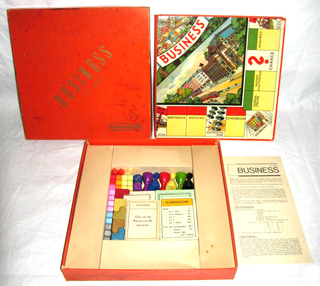 Edition:
Business (- Vienna) - square
red box Edition:
Business (- Vienna) - square
red box
Ges.Gesch. (Protected by law)
Publisher: Schowanek - ±1936
Dimensions of the box: 26 x 26 x 4 cm
of the board: 49 x 49.5 cm
The game:
This square box of Austria's early Bussiness editions is also from the
collection of Phil Orbanes - USA.
There are 2 theories about the age of this edition: Will it be
published in the same period as the long box (so about 1936)
or just a few years later (about 1939)?
1. With papermoney, aggravation pawns
as tokens and simpler houses and hotels a cheaper version can be
offered
next to the more luxury edition with
its hand-made wooden tokens and wooden coins. This theory pleads for
publication in 1936.
2.The materials of
the money and cards look more modern than that of the original game. This
impression pleads for
its publication to be in say ±1939, anyhow before W.W.II.
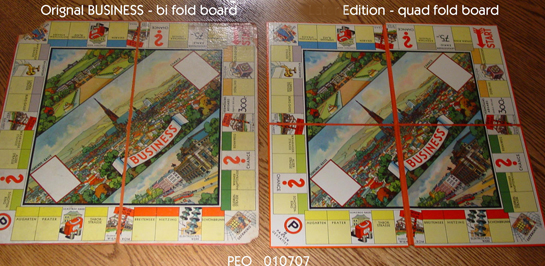 Typical
details of the set: Typical
details of the set:
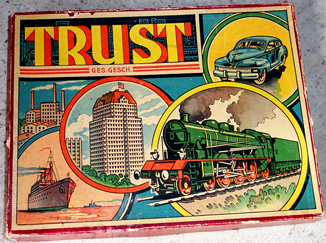 Edition: Trust Edition: Trust
Ges.Gesch. (Protected by law)
Publisher: Unknown inland manufacturer - ±1939
Dimensions of the box: 31.0 x 23.5 x 3.3 cm
of the unfolded board: 29.6 x 50.7 cm
The game:
This set is from the collection of Ian Brown - UK
Ian may not have found a compatitor publisher but this edition is another
precursor anyhow of the later DKT editions. There are two strong reasons
why this edition is from the same period as the above mentioned
"Business"editions:
 | The first indication the company goes for a patent, shown by the remark Gesetzlich
Geschützt (Protected by law)
a claim also filed by Schowanek for the same kind of game. |
 | The car shown
on the lid is of a design of that era; compare the image of a Dogde from
1939. |
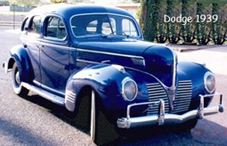 On the other hand it may
well be possible both "Trust" and "Business" to be
publications of the same manufacturer, perhaps to test which design will
be the best accepted in the market? On the other hand it may
well be possible both "Trust" and "Business" to be
publications of the same manufacturer, perhaps to test which design will
be the best accepted in the market?
From what we now know of the development of the DKT editions is this all
ended up in the publications of Stomo Spiele very soon.
This game already has all elements of the Parker Monopoly design, only its
presentation differs.
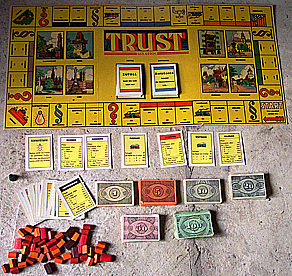 "Trust"
is a game with 8 clusters of 2 to 4 Austrian cities of a region.
The center of the long game board shows images of 8 of the cities mentioned: Klagenfurt
- Graz - Wien - Linz - Innsbruck - Salzburg - Bregenz and Eisenstadt. "Trust"
is a game with 8 clusters of 2 to 4 Austrian cities of a region.
The center of the long game board shows images of 8 of the cities mentioned: Klagenfurt
- Graz - Wien - Linz - Innsbruck - Salzburg - Bregenz and Eisenstadt.
All unnumbered properties are from 21 Austrian cities and are from
Start
onwards:
§-Amtskasse (Community Chest) - Hallein
- Salzburg
- Westbahn  - Kufstein - Kitsbuhel
- Innsbruck - Sudbahn - Kufstein - Kitsbuhel
- Innsbruck - Sudbahn  - Zufall
- Dornbirn
- Bregenz
- §-Amtskasse - Elektrzitätswerk - Gericht (Court)
- Zufall - Klagenfurt - Villach
- Wolfsburg - §-Amtskasse -
Urlaub - Zufall - Mattersburg - Eisenstadt
- §-Amtskasse - Nortbahn - Zufall
- Dornbirn
- Bregenz
- §-Amtskasse - Elektrzitätswerk - Gericht (Court)
- Zufall - Klagenfurt - Villach
- Wolfsburg - §-Amtskasse -
Urlaub - Zufall - Mattersburg - Eisenstadt
- §-Amtskasse - Nortbahn  - Wr.Neustadt
(Wiener Neustadt) - St.Pölten
- Wien - Wasserwerk (Water
Works) - Ostbahn - Wr.Neustadt
(Wiener Neustadt) - St.Pölten
- Wien - Wasserwerk (Water
Works) - Ostbahn  - Wels - Gmunden
- Linz - Gefängnis - §-Amtskasse
- Leoben - Hartberg
- Graz and Zufall. - Wels - Gmunden
- Linz - Gefängnis - §-Amtskasse
- Leoben - Hartberg
- Graz and Zufall.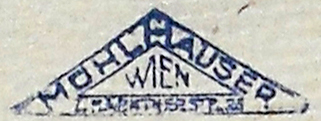
< Although there is a veil of obscureness over the manufacturer of this
edition we found this logo of a distribution outlet in Vienna on the
bottom of this set.
Notes:
 | Each group of properties always remain on one side of the board, so they
never round the corner. |
 | The names of the spaces are shown twice. |
 | The prices of the properties varies over the board between 80 and
400, without any clear structure. |
 | All engines on the stations are colored differently. |
 | The long, solid board is folded twice in order to fit into the small
box. |
 |
The property deeds (sizes: 76x55 mm) are white cards with the rents given
in a yellow
field and an empty back side, like the Zufall and
Amtskasse cards
(sizes: 71x53 mm).
A few instructions of the Zufall and Amtskasse
cards read:
 | Bekommt ein Grundstück gratis. (Get a property for free
) |
 | Kommt vors Gericht. (Appear in court) |
 | Bezahlt für Gewerbesteuer 170,-. (Pay 170,- company tax) |
 | Erhält für Dividende 35,-. (Receive 35.- for dividend) |
|
 | The back side of the the property deeds are black with no reference
to any mortgage, but according to the
Rules showing the black back
of a card is sufficient to show a property has been mortgaged. |
 | The player who lands on Gericht is considered to be accused; he/she
has to throw once more. Is the number even player is free and shall continue
his
way for that number. Is the number odd so will player be guilty and has to
pay S 50.- for courtcosts and goes to Jail. From this point on this corner
acts
as the well know Jail and its rules. |
 | There are 6 small banknotes (sizes: 74x49 mm) printed in black
on colored paper, in the denominations: 1
- 5 -10
- 20 - 50
and 100. The currency
is Spielmark (Play mark). |
 | There are 64 dark red and orange
houses and 16 red and black
hotels in this set, but I think these double quantities
comes from other games. |
 | There were no tokens with this edition and only one black die. |
Do you know Argentina
also launched "TRUST" editions, many years later? However, they have
for sure nothing to do with this Austrian version.
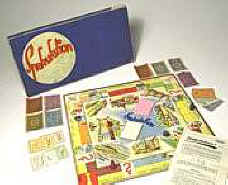 Edition: Spekulation - long
blue box Edition: Spekulation - long
blue box
Publisher: Stomo Spiele - 1937
Dimensions of the box: ±25 x ±50 cm
The game:
In the past the DKT site used to
introduce the history of their games as follows:
"This game was designed in 1936 by the editors of the company "Wiener Druckerei Stockinger und Morsack"
(founded in 1868). The 1937 issue (see the picture of the long, blue
box) already clearly shows the typical DKT design. The game board,
box (?) and tokens are almost identical to those of the
present-day design, except for the larger banknotes.
This set was sold for RM 4.- in Wien, 1939.
A very poor WW II edition from 1940/41 suddenly appears as "DKT"
instead of "Spekulation".
What can be the reason for that? Was it fear for "reichsdeutschen Zensur"
(Nazi censorship)? Because a game with speculation,
property trading, stock market trade a.s.o. would not have well correspond to
the Nazi German doctrine. That is why a new name emphasizing the essence of
the game was searched for. With "Das kaufmännische Talent" (Traders
talent) the instructive components of the game were stressed. Without
any problem and painless this game under the name of DKT sustained the Nazi
oppression in Austria.
The trademark was registered in the fifties, the game board was changed
(see the differences between the "blue
box" and "red box"
editions), however, the manufacturer (STOMO Marke gesch.) remained the
same."
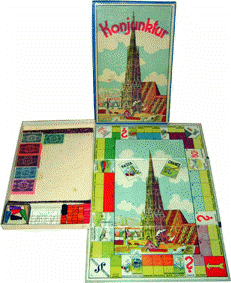 Edition: Konjunktur
(economic situation)(- Vienna) - long blue
box Edition: Konjunktur
(economic situation)(- Vienna) - long blue
box
Publisher: Unknown inland manufacturer - ±1947
Dimensions of the box: 42.5 x 27.0 x 3.5 cm
of the unfolded board: 39.5 x 59.7 cm
The game:
This edition, with properties of Vienna, proudly showing the Stephansdom is from the collection of Roland Klose - D.
Although there is no name of the manufacturer to be found, nor on the box,
game board or Rules, there are so many matches with the later DKT
editions that it is very likely this edition to be a precursor of them and
consequently the maker is almost certainly Stomo Spiel.
The property deeds are printed on the back of military maps (of the Split and Kosovo area in
former Jugoslavia) one of which showing the year 1943. Since these maps will not
have been re-used to make property deeds of during WW II it must have been after
the war, reason why we have estimated the year of publication to be abt. 1947.
Typical matches between Konjunktur and DKT are to be found in the
design of the game board, such as:
 | the same yellow
arrow in an empty red Start square. |
 | the streets of a group near a corner are situated on both sides of that
space. |
 | the "stations" are on spaces (8) - (13) - (24) and (34), so
random distributed over the board. |
 | the Gesetzes-§ Verletzung (Law-section Injury)
corner nr. (11). |
 | an additional utility space Sender on (14). |
 | a Property-tax space on (21) rather than a Free Parking. |
 | the Jail isn't called a jail but "Zelle 3" (with DKT)
or "Zelle
7", situated at corner (31). |
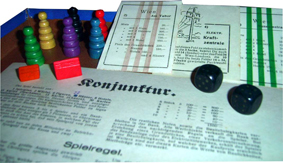 But
there are even more matches, such as:7,5 cm x 5,0 cm But
there are even more matches, such as:7,5 cm x 5,0 cm
 | the small banknotes (ca. 7.5 x 5.0 cm) in but 6 denominations: 1 - 5 - 10 - 20 - 50 and
100. (This copy has 2 different
sets sets: 1x printed in black on colored paper and 1x printed in blue
on white paper. |
 | no more than only 8 hotels. |
Furthermore there is to be mentioned:
 | The unusual long game board, longitudinal folded twice. |
 | It is very striking that the prices of the properties are purely randomly
distributed over the 4 sides.
The arrangement for mortgage is also peculiar, because it can be negociated
with the banker! |
 | The property deeds (ca. 6.5 x 5.0 cm)
all confirm the street to be from Vienna. They have 3 vertical colored
lines rather than a color bar on top the
card. |
 | The 32 houses and 8 hotels
have almost the same sizes. |
 | The 6 colored wooden tokens consisting of a base with 3 concentric rings and a
small ball on top. |
 | Both dice are black with goldy pips. |
All numbered properties are from Vienna and are from Start (1)
onwards:
Am Tabor (2) - Chance (3) -
Elektr.Kraftzentrale (4) - Michaeler Platz
(5) - Thalia Str. (6) - Opernring
(7) - Eisenbahn Wien-Linz (8) - Sparkasse (9) - Haydn
Gasse (10) - Gesetzes- § Verletzung (11)
- Schönbrunner Str. (12) - Donau Dampf
Schiffahrt Wien-Budapest (13) - Sender (14) - Kärtner
Str. (15) - Mariahilfer Str. - Koblenz
Str.(17) - Elektr. Bahn Wien Baden - Land-Hauptstr.
(19) - Stift-Gasse (20) -
Vermögensabgabe (property-tax) 10% (21) - Museum Str. (22)
- Chance (23) - Autobuslinie Glockner Str.(24) - MirabellPlatz
(25) - Westbahnstr.(26) - Universitätsplatz
(27) - Sparkasse (28) - Burggasse
(29) - Babenbergerstr.
- Zelle 7 (Jail) (31) - Althan
Platz (32) - Erwerbssteuer (33) - Fluglinie Wien-London
(34) - Maria Theresien Str. (35) - Andreas
Gasse (36) - Morzin Platz (37) - Chance
(38) - Wiedner Hauptstr. (39) and Rathaus
Str. (40).
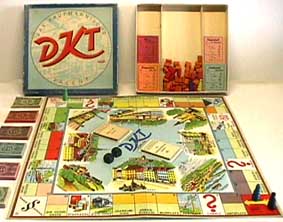 Edition: DKT
- Small box - blue, without Art.Nr. Edition: DKT
- Small box - blue, without Art.Nr.
Publisher: Stomo Spiele Marke gesch. - ± 1950
Dimensions of the box: 25.5 x 25.5 x 3.0 cm
The game:
Typical for DKT games are:
 | The illustrations on top the group of streets. That is why the streets belonging to the corner pictures round the corner. |
 | But for a rare exception the game is always in a square box with the game board folded twice. |
 | Properties Elektrisches Kraftwerk (4), Sender (14) and Wien-Venedig (34) form a group. One card entitles to a rent of
5x
the number thrown, two cards 10x and all three cards 20x. |
Typical for this early edition is:
 | The illustrations are simple and austere and the transport means are very
old fashioned. |
 | The Graz illustration only shows a monument on the square, without
market stalls. |
 | The Salzburg bridge is empty, no trafic. |
 | No truck next to the statue on the square of Linz. |
 | The solid game board's back is light
green. |
 | There is no rim wih the figures 1 to 40 (later used to
count the rounds) along side 3. |
 | The bottom of the box is untreated cardboard. |
 | The property cards (61x81 mm) are in the same color
as the bar on the board. |
 | The 15 small, numbered Chance cards (52x67 mm) are
one side printed on light beige solid
paper; the Sparkassa cards are of light blue
green solid paper. |
 | The money consists of 6 small (50x75 mm) neutral banknotes
the value printed in black on colored paper: 1
- 5 - 10
- 20 - 50
and 100. |
 | There are 32 oblong (10 mm), beige,
wooden houses and only 8 twice as long (20 mm), red,
wooden hotels. |
 | The 6 colored tokens are ring shaped, wooden pawns. |
 | Both dice are black with gold pips. |
The instructions on the Chance and Sparkassa cards differ from those
of the Monopoly cards. However, there are house and hotel repair cards. Some of
the other instructions read:
 | Für Autoreparatur zahle 140.- (Pay for car repairs 140.-). |
 | Für unerlaubtes Parken bezahlst Du 10.- (Pay 10.- for
unlawful parking). |
 | An Reisespesenbeitrag erhälst Du 40.- (You get 40.- as
contribution to your travelling expenses). |
 | Für Gehsteigreinigung bezahle 40.- (Pay 40.- for pavement
cleaning).
|
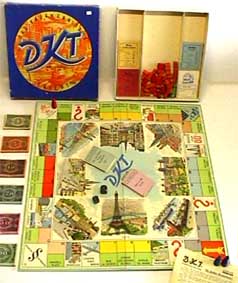 Edition: DKT - Europa Ausgabe -
small box - blue, without Art.Nr. Edition: DKT - Europa Ausgabe -
small box - blue, without Art.Nr.
Publisher: Stomo Spiele Marke gesch. - ±1950
Dimensions of the box: 25.5 x 25.5 x 3.0 cm
The game:
Because of the many similarities in execution of this blue
box and the one of the standard edition I believe it to be issued in the same era. However,
the illustrations on the game board are more detailed and shaded and the
transport means are at least a number of decades more modern. All rims of the
lid are illustrated, while 2 of them also show DKT.
Typical for this edition is:
 | The Salzburg bridge shows trafic. |
 | The solid game board's back is light
green. |
 | There is still no rim wih the figures 1 to 40 (later used to
count the rounds) along side 3. |
 | The bottom of the box is untreated cardboard. |
 | The property cards (61x81 mm) are in the same color
as the bar on the board. |
 | The 15 small, numbered Chance cards (52x67 mm) are
one side printed on light blue green
solid
paper; the Sparkassa
cards are of light
purple solid paper. |
 | The money consists of 6 small (50x75 mm) neutral banknotes
the value printed in black on colored paper: 1
- 5 - 10
- 20 - 50
and 100. |
 | There are 32 oblong (10 mm), beige,
wooden houses and only 8 twice as long (20 mm), red,
wooden hotels. |
 | The 6 colored tokens are ring shaped, wooden pawns. |
 | Both dice are black with gold pips. |
 | The Rules are in English and French. |
The 8 cities are selected from only 5 European countries. Why? There are a few more countries in
Europe.
These cities, the stations and the other spaces are:
Hamburg: Jungfernstieg (39) -
Mönckibergerstr (40) - Neuer Wall (2) - Chance (3) -
Wasserkraftwerk (4)
Paris:
Avenue du Maine (5) - Avenue des Champs Elysees (6) - Rue la Fayette (7) - London
Paris Berlin
(8) (aviation) - Sparkassa (9)
Salzburg: Mirabellplatz (10) - Gesetzes-§Verletzung
(11) - Getreidegasse (12) - Hamburg Amerika (13) (navigation) - Gaswerke (14)
Berlin: Potsdamerstrasse (15) -
Brandenburgische Strasse (16) - Kurfürstendamm (17) - Berlin-Wien (18) (railways)
Zürich: Limatquai (19) - Bellevueplatz (20)
- Vermögensabgabe 10% höchstens 350.- (21)
-
Bahnhofstrasse (22) - Chance (23) - München-Villach (24) (bustransport)
Wien:
Kärntnerstrasse (25) - Mariahilferstrasse (26) - Schönbrunnerstrasse (27) - Sparkassa
(28)
München: Schillerstrasse (29) -
Senglingerstrasse (30) - Zelle 3 (jail)
(31) - Kaufingerstrasse (32) - Finanzamt Steur 80.-
(33) - Erdölgewinnung
(34)
London: Holland Road (35) - Piccadilly
(36) - Oxford Street (37) - Chance (38)
The price of this set amounted to DM 20, - (€ 10.30) October 1998.
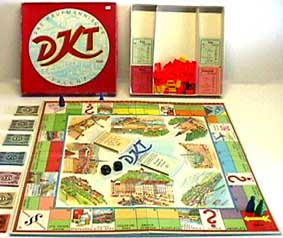 Edition: DKT
- Small box - red, without Art.Nr. Edition: DKT
- Small box - red, without Art.Nr.
Publisher: Stomo Spiele Marke gesch. - ±
1955
Dimensions of the box:25.5 x 25.5 x 3.0 cm
The game:
This edition is different and more modern compared to both blue
boxes described before this. Not only are the illustrations on the game board
more detailed and shaded and the transport means at least a number of decades more modern, but the houses and hotels are made
of plastic now. Again all rims of the lid are illustrated, while 2 of them
also show DKT.
Typical for this red edition is:
 | The Graz illustration now shows market stalls around the monument on the
square. |
 | The Salzburg bridge is with trafic now. |
 | There is a truck next to the statue on the square of Linz. |
 | The solid game board's back is light
green. |
 | A rim wih the figures 1 to 40 is introduced along side 3.
This is to count the number of rounds. For that purpose an aggravation pawn
is added to this game. |
 | The bottom of the box is still untreated cardboard. |
 | The property cards (61x81 mm) are in the same color
as the bar on the board. |
 | The 15 small, numbered Chance cards (52x67 mm) are
one side printed on light beige solid
paper; the Sparkassa cards are of light blue
green solid paper. |
 | The money now consists of 7 even smaller (43x60 mm) neutral banknotes
the value printed in black on colored paper: 1
- 5 - 10
- 20 - 50
- 100
and 200. |
 | There are 32 oblong (17 mm), red,
plastic houses and only 8 20 mm, yellow,
plastic hotels. All have overhanging roofs. |
 | The 6 colored tokens are ring shaped, wooden pawns. |
 | Both dice are black with gold pips. |
The price of this set amounted to DM 17, - (€ 8.80) October 1998.
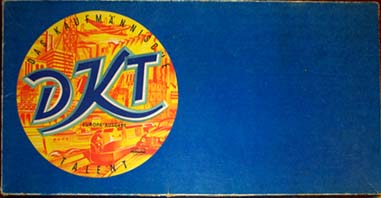 Edition: DKT
- Europa Ausgabe - long box - blue, without Art.Nr. Edition: DKT
- Europa Ausgabe - long box - blue, without Art.Nr.
Publisher: Stomo Spiele - Marke gesch. - ±1960
Dimensions of the box: 26 x 50 x 4 cm
The game:
This bilingual edition is from the collection of Ian Brown - UK
Because of the fact that this Europe edition has the "number of rounds
count rim" (along side 2), in contrast to that of the
square blue box mentioned before, this long
box must be issued about 1960.
The 8 cities are selected from only 6 European countries now.
From the yellow
arrow the properties are:
Hamburg: Jungfernstieg (39) -
Mönckibergerstr (40) - Neuer Wall (2) - Chance (3) -
Wasserkraftwerk/Installation Hydraulique (4)
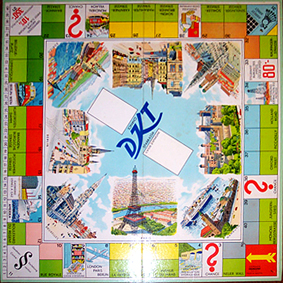 Paris:
Avenue du Maine (5) - Avenue des Champs Elysees (6) - Rue la Fayette (7) - London
Paris Berlin
(8) (aviation) - Paris:
Avenue du Maine (5) - Avenue des Champs Elysees (6) - Rue la Fayette (7) - London
Paris Berlin
(8) (aviation) -
Sparkassa/Caisse
d'épargne (9)
Bruxelles: Rue Royale (10) - Gesetzes-§Verletzung
(11) - Getreidegasse (12) - Hamburg Amerika (13) (navigation) -
Gaswerke/Usines a gaz (14)
Berlin: Potsdamerstrasse (15) -
Brandenburgische Strasse (16) - Kurfürstendamm (17) - Berlin-Wien (18) (railways)
Zürich: Limatquai (19) - Bellevueplatz (20)
- Vermögensabgabe/Impot sur la fortune 10% höchstens/Tout
au plus 350.- (21)
-
Bahnhofstrasse (22) - Chance
(23) - München-Villach (24) (bustransport)
Wien:
Kärntnerstrasse (25) - Mariahilferstrasse (26) - Schönbrunnerstrasse (27) - Sparkassa/Caisse
d'épargne
(28)
München: Schillerstrasse (29) -
Senglingerstrasse (30) - Arrest/Arrêt (31) - Kaufingerstrasse (32) - Finanzamt Steur 80.-
(33) -
Erdölgewinnung/Extraction du pétrole (34)
London: Holland Road (35) - Piccadilly
(36) - Oxford Street (37) - Chance (38).
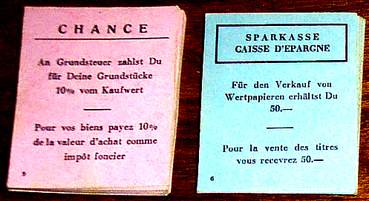 Other features of this edition are:
Other features of this edition are:
 | Only one short end of the lid shows a train and boat image, next to
the DKT logo. |
 | The bottom of the box is untreated cardboard. |
 | The Sparkassa/Caisse d'épargne cards are of light blue
green solid paper, the Chance cards are pink. |
 | The money consists of 7 small (60x42 mm) neutral banknotes
the value printed in black on dull colored paper:
1
- 5 - 10
- 20 - 50
- 100
and 200. |
 | The 6 colored tokens are ring shaped, wooden pawns. |
 | A small black pawn has to be used to count the number of
rounds played during the game.
An additional sheet to the Rules explains in German and French how to act in
case of a short game: "The line
with figures along one side of the game board is to count the number of
rounds agreed upon - before starting -
in case, because of a long duration of the play, one doesn't want to
play till there is but one player left. The
player who started to play the game places the small pawn on nr. 1 of the
"count rim" and the moment it is his
turn again he puts the pawn 1 place forward. The moment the pawn arrives at
the number of rounds agreed upon,
the end of the game has been reached." (Today symply a certain time
span is a greed on!) |
 | There are 34 wooden houses and 8 hotels
in this set, but probably 2 houses too much. |
 | Both dice are black with gold pips. |
 | The Rules as well as the cards, are in German and French. |
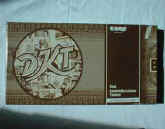 Many years later, in about 1987 a Dutch edition was
issued as DKT
- Europa De Luxe, under Art.Nr.180 29. In this version the cities Many years later, in about 1987 a Dutch edition was
issued as DKT
- Europa De Luxe, under Art.Nr.180 29. In this version the cities
Hamburg and
Berlin are replaced by Frankfurt
and London.
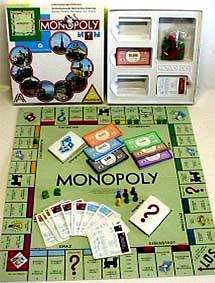 Edition: Monopoly - small box, Nr. 6407 Edition: Monopoly - small box, Nr. 6407
"Das kaufmännische Spiel mit dem Welterfolg" ("The global winner trading game")
"Lizenz Parker Brothers Inc. U.S.A.
"
Publisher: Parker Brothers/Piatnik - Wien - 1981
Dimensions of the box: 25.6 x 25.6 x 3.4 cm
The game:
Since 1950 the world famous cards manufacturer Piatnik started to make
party games, among which also the first editions of Parker Brother's Monopoly.
However they only did so for about 30 years, until about 1990 as Parker/Tonka
continued to manufacture the games in France.
In the middle of the game board 1961 is the latest copyright year mentioned
together with the remark "Alleinhersteller Wiener Spielefabrik Ferd.Piatnik
& Söhne, Wien"(Solemanufacturer Wiener Spielefabrik
Ferd.Piatnik & Sons, Vienna).
On the other hand the Rules show 1981 as latest copyright year. That may
indicate that this edition remained unchanged over at least 20 years.
The period 1960/80 was apparently an era of searching and orientation for
Parker Brothers, because all over Europe licencees changed or contracts were not
continued. This was f.e. the case with Piatnik.
Although it is a bit hidden by 9 pictures of landmarks of the cities
mentioned on the game board, the lid of this Austrian edition has the
same design as in other European countries, i.e. "a game
board in a green
in a blue square with the red
Monopoly bar next to it and the logo of Rich Uncle Pennybags in a red square inbetween 2 blue
Parker locomotives". In the red
square is the number 77314. In the blue
field is the manufacturer's name, while on top the red
bar it says "Lizenz Parker Brothers Inc. U.S.A.".
There is no "Parker swirl" but the Piatnik
logo instead. The red Monopoly bar is on all 4 sides of the lid.
There is
nothing printed on the bottom of the box.
The game board is of not too solid a cardboard and is double folded in
such a way that the play side is turned outwards. It's back is white. Only on
the streets and stations the names of the properties are mentioned twice in order they
can be read from all directions. All spaces, starting from Los are numbered.
The cities the streets belong to are mentioned on top the group.
In the board's centre is Monopoly written in black, closed characters,
parallel to the 1st side.
The insert in the innerbox is of soft white plastic and has 5 holes for
the cards and other attributes.
The back side of the white Ereigniskarten (Event
cards) show a
red ?, whereas the Gemeinschaftskarten (Community
cards) of course show the blue
treasure chest.
The banknotes are of one side color printed white paper and show except
for the word Monopoly and the figure in the central circle "pat.app.for Nº
3796-36". The 7 denominations are in Schilling:100
- 500 - 1.000
- 2.000 - 5.000
- 10.000
and 50.000.
There are 6 plastic aggravation pawns as tokens. The wooden
houses
are green, the hotels red.
Both dice are green with gold pips.
This
edition was manufactured in Austria.
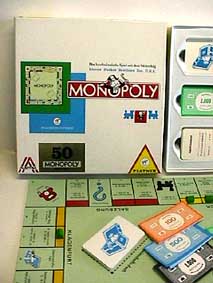 Edition: Monopoly - 50 Jahre, small box, Nr. 6408 Edition: Monopoly - 50 Jahre, small box, Nr. 6408
"Das kaufmännische Spiel mit dem Welterfolg" ("The global winner trading game")
"Lizenz Parker Brothers Inc. U.S.A.
"
Publisher: Parker Brothers/Piatnik - Wien - 1985
Dimensions of the box: 25.6 x 25.6 x 3.4 cm
The game:
Apparently Parker Brothers have not issued a special edition in Austria
for
the 50th anniversary of their Monopoly game, because only a gold sticker saying
"50 Jahre - Monopoly - 1935-1985" is on the lid of a standard
white box.
Except for the absence of the 9 pictures in circles and consequently a
larger presentation of the design of "a game
board in a green
in a blue square with red
Monopoly bar with under that the logo of Rich Uncle Pennybags in a red square inbetween 2 blue
Parker locomotives" all the rest is exactly the same in this
edition as in the one with Nr. 6407.
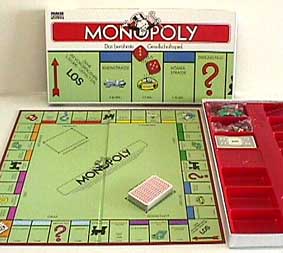 Edition: Standard
long box,
Ref. Nr. 690281 Edition: Standard
long box,
Ref. Nr. 690281
Publisher: Parker Brothers/Tonka - 1991
Dimensions of the box: 26 x 51 cm
The game:
(The Art.Nr. is only mentioned on the play side of the game board.)
The cover design is more colorful than before and it shows the red
bar with Uncle Pennybags on top the picture of a part of the fourth
side of the board. The dice show 3 and 5. There is nothing printed
on the bottom of the box.
.
The game board has a blue green
midfield and its back is red. Monopoly
is in closed, black characters in a frame diagonally
on the midfield.
The
tray is of soft red plastic and
is divided into 13 sections for the banknotes, cards and other attributes.
The banknotes show in the circle "Monopoli® - Monopoly® - Monopol®"
and "Copyright 1935 by Parker Brothers USA". The 7 denominations are:
100 (black on white) -
500
- 1.000 -
2.000
- 5.000 - 10.000
and 50.000.
The green houses and red
hotels are of plastic and have overhanging roofs. The 8 pewter tokens are
thimble - boat - shoe - car -
hat - iron - dog and wheelbarrow.
Both dice are red with gold pips.
This edition was "Made in France".
The set described was bought in Bregenz for S 498 (€ 36.35 ) April 1993.
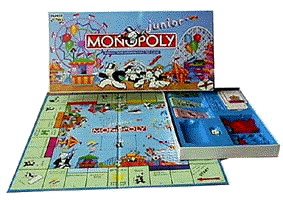 Edition: Junior
standard - German, Ref.Nr. 690260 Edition: Junior
standard - German, Ref.Nr. 690260
Publisher: Parker/Tonka Int.Inc. - 1991
Dimensions of the box: 23.5 x 46.3 cm
The game:
Just like in the regular Monopoly game the aim is to collect as much money as
possible. The moment one of the players runs out of money the other players
must count up their money to see who has won the game.
The back of the board is
blue, like the tray in the box. The game
board is folded vertically. On the bottom of the box is a black and white
picture of the board and all attributes. The money consists of one side
printed notes of 1 to 5 with Uncle Pennybags in various situations the
centrefield.
Four children can play at the same time, because there are 4 cars,
respectively yellow, red,
blue and green.
The ticket booths are to be distributed amongst the players with the same
color of car. The game is called Auf dem Monopoly-Rummelplatz and will be
over in about 20 minutes. Uncle Pennybags brings you to the roller coaster,
magic show, water chute, dodgems, puppet show, miniature golf, a.s.o. In the
coarse of the game ticket booths can be bought to place on an Amusement
so that it becomes your property. If you also own the other Amusement of the
same color, a visitor must pay double the amount shown on the space. There are 6 Ereignis
(Chance) spaces where cards can be drawn with instructions like "Du
gehst zur Wasserrutsche" (Go to the water chute) and "Du zahlst DM
3.- in die Wundertüte und gehst in die Mittagspause" (in the English
version: "Pay 3.- to take the tram to the cafe"). The dimensions of
the tickets are: 55 x 84 mm.
The game was manufactured in France and is distributed in Germany,
Austria and Switserland.
The set described was bought in Bregenz for S 249 (€ 18.15 ) April 1993.
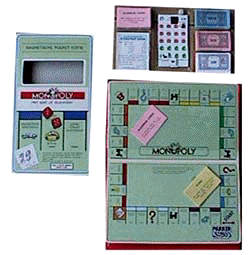 Edition:
Magnetic
Pocket Edition - Österreich Ausgabe,
Barcode Nr. 028970 Edition:
Magnetic
Pocket Edition - Österreich Ausgabe,
Barcode Nr. 028970
Publisher: Parker/ Tonka - 1991
Dimensions of the little case: 1.5 x 10.5 x 18 cm
The game:
This travel edition has about the same size as a pocket diary. The red
folder is packed in a cover with a window. That window shows the Monopoly
bar when the folder is put in. The back side of the box shows a picture of
the little game board with all attributes. The attributes are in a extendable
little tray that is hard to use on a journey. The flat tokens, houses
and hotels do stick on the surface of the game board, but there are no
facilities for the small and clumsy banknotes (25x47mm), Ereignis and
Gemeinschaftskarten (26x44mm) and property
deeds (44x52mm), so that these things have to be hand held?
The mini-dice (5x5x5mm)
are white with a red dot for the 1 while the
other pips are black.
This is not a very practical version, however it ought to be in a collection.
The set described was bought in Bregenz for S 259 (€ 18.90 ) April 1993.
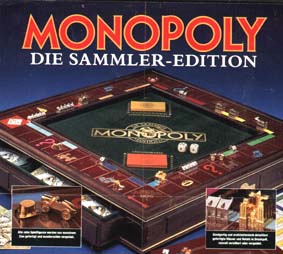 Edition:
Die Sammler-Edition Edition:
Die Sammler-Edition
Publisher: Franklin Mint - 1992
Dimensions of the table: 7.5 x 52.5 x 52.5 cm + pedestal
The game:
Without exaggeration this "authorized" issue can be called the game
of the games.
The board is made of distinguished mahogany
stained hardwood with a green felt-lined
sunken midfield. The printing is in gold. Underneath the playfield is a sliding
drawer for the banker, also green felt-lined.
The drawer has a knob provided with a brass Monopoly game coin. On the other 3
sides of the set is a brass Monopoly plate.
The background of the streets is of the same mahogany
colour
as the wood. Even the instructions and the "Real Estate
Portfolio" are in this dignified colour.
All 10 classic playing tokens are crafted in pewter and embellished with 22
carat gold, amongst them a purse and a hurrycane latern. The architecturally-designed houses and hotels are dycast
and plated with silver and gold.
Also the banknotes have a luxury appearance and are special made for this
Collector's Edition. The number of banknotes is twice as much as usual. But for
what reason?
The red Ereignis-
and yellow
Gemeinschaftskarten have all funny illustrations with Uncle
Pennybags, as usual.
The wooden pedestal for
this set contains another 4 drawers for the players to collect their money and
property cards. Finally the set can be covered by a glass plate, to
protect for dust.
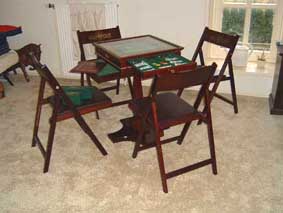 The
1998 Sommerkatalog of the Austrian Franklin Mint shows the German
set was still available. Prices: The
1998 Sommerkatalog of the Austrian Franklin Mint shows the German
set was still available. Prices:
 |
game S 9,500.- (€ 690.-) |
 |
pedestal S 4,350.- (€ 316.-) |
 |
glass cover S 1,650.- (€ 120.-) |
 |
"Millionaire's Chairs", per pair S 4,475.- (€ 325.-) |
 |
Official Monopoly 60th Anniversary clock
for Millionaires S 2,950.- (€ 214.- ) |
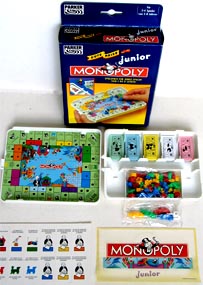 Edition:
Gute Reise Junior - German, Ref.Nr. 06607100 Edition:
Gute Reise Junior - German, Ref.Nr. 06607100
Publisher: Parker/Tonka/Hasbro -
1992
Dimensions of the little white box: 13.5 x 17.0 x 1.8 cm
The game:
The little white box consists of a lid, with a little game board
inside, and a bottom part also to be used as banker's tray. A
separately supplied sticker has to be put on the lid as yet.
Like in the large editions there are 4 colored cars for the players.
Because the board is so small the cars have to be pinned into the board vertically.
When a player lands on a space already occupied by a token, he has to continue
to the next field.
Each player receives 10 (with only 2 players 14) put in
in the same color of his car at the start of the game as well as a pocket money
of DM 31.- in total. Because of the resticted space the ticket booths must be
pinned upon each other.
The 24 Ereignis cards (2.5x4.2 cm) have to be torn loose yet from
the joint paper. Next they must be put in the for that destined hole of the
banker's tray. The instructions on these cards are exactly the same as those of
the larger games.
In this banker's tray also the 5 tiny banknotes (1 - 2
- 3 - 4
and 5) must be put in the for that destined
holes.
The game is played the same way as the larger editions. Winner is the one, who
after 1 player ran out of pocket money is the richest.
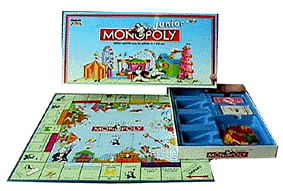 Edition:
Junior
standard - German, Ref.Nr. 05415D Edition:
Junior
standard - German, Ref.Nr. 05415D
Publisher: Parker/Hasbro - 1994
Dimensions of the box: 24.5 x 48.5 cm
The game:
The differences between this issue and the one of 1991 are:
 | A slightly larger box and game board. |
 | A total new illustration on the cover: Uncle Pennybags is running (now
with a different group of children) over the
fourth side of the game board. |
 | On the bottom of the box is a color picture of 2 girls and a boy sitting
around the board. |
 | The game board is horizontally folded. |
 | The illustrations on the banknotes are in white on a colored background. |
 | This set was made in Ireland. |
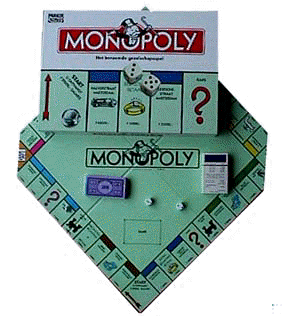 Edition: Standard, Ref.Nr.14535/156 Edition: Standard, Ref.Nr.14535/156
Publisher: Parker/Tonka/Hasbro - 1996
Dimensions of the box: 26.8 x 40.3 x 5.3 cm
of the double folded board: 25.2 x 25.2 cm
The game:
This edition is a sample of the "new look" of the games who are manufactured
in the Irish works. The fresh white box shows a red
bar and a part of the fourth side of the board on the lid. The dice shown have a
3 and 5. The width and the
length of the boxes are standardized for all of their games Hasbro told us. So
herewith the long box we've called Standard so far disappears.
This new box contains a red plastic tray
insert with newly shaped slots for the banknotes and title cards of the banker.
The board is folded in four like in the so-called "small box".
The back side is red and the play side is blue
green. The set is manufactured in Ireland and so it has again a
picture of a "laughing family" at the back of the box. On the board
are the nice Ereignis- and Gemeinschaftskarten.
The color of the first 2 streets, Eszterhazystrasse
and
Schlosspark, has been changed into braun
from this issue on. The banknotes
are of the new model, i.e. with a black Monopoly ribbon and Uncle Pennybags in
the upper part of the circle and, almost unvisible, the remark "1996 Tonka
Corporation" at the lower end.
The 10 tokens are of pewter and likely no longer manufactured in
China.
The green, plastic houses do have a
chimney, the red hotels don't.
Both dice are white with black pips.
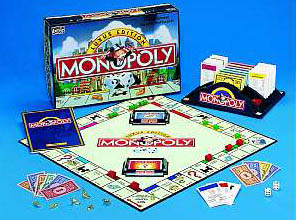 Edition:
Luxus Edition, Ref.Nr. 14549/156 Edition:
Luxus Edition, Ref.Nr. 14549/156
Publisher: Parker Bros./Hasbro Inc. - 1996
Dimensions of the box: 26.8 x 40.3 x 8.8 cm
of the double folded board: 25.2 x 25.2 cm
The game:
Again a great issue of "the famous party game". The box has the same
length and width sizes as the one of the "standard" edition, in
contrast to the American Deluxe edition, of which the box is still long.
Unfortunately both these boxes are rather vulnerable, but the content is well
taken care of: Inside the box are, besides the solid game board (with dark
blue back) a soft plastic insert with 4 trays for the houses and
hotels, but in particular the never before used "Banker's Tray",
a well shaped money-and-cards-holder of solid blue
plastic. One have to put the separate stickers on both this tray as well as the
2 separate card holders (for the Ereignis and Gemeinschaftskarten) yourself. The
clear color picture at the bottom of the box gives a good total impression of
the set.
This time the lid shows a part third side of the game board, so with
properties of
Innsbruck
as well as a part of the tap. The car and shoe are 2 of the 10
gold colored tokens shown on these streets.
The dice right under (from now
on) Mr.Monopoly with red bow tie show
4 and 1 on top.
The banknotes
are the same as those of the "standard" edition.
The houses and hotels are made of nice glossy wood.
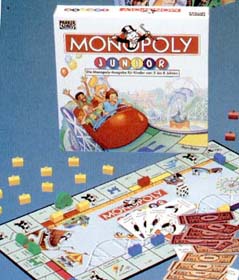 Edition: Junior
standard - German, Ref.Nr. 14540D Edition: Junior
standard - German, Ref.Nr. 14540D
Publisher: Parker Bros./Hasbro - 1996
Dimensions of the box: 26.8 x 26.8 cm
The game:
The differences between this version and those of the preceeding years are:
 | A totally new square box. |
 | A new illustration on the cover: Children in a roller coaster cart with 2
jumping dolphins in the background. |
 | The color picture on the bottom of the box shows a scene again of 2
(different) girls and a boy. The money they use is
that of the 1991 game. |
 | Now the game board is oblong: 25 x 50.5 cm. |
 | The back of the board is red
like the plastic tray in the inner box. |
 | The money is the same as of the 1994 game. |
 | The Ereignis (Chance) cards have become much smaller in size: 43
x 63 mm. |
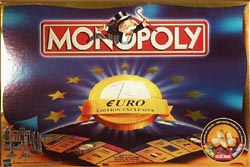 Edition:
Monopoly Euro - German, Ref.Nr. 05597/100 Edition:
Monopoly Euro - German, Ref.Nr. 05597/100
Publisher: Parker/Hasbro - 1999
Dimensions of the box: 27.0 x 40.2 x 6.5 cm
The game:
Of course Parker/ Hasbro took the opportunity of the introduction
of the Euro to issue a special edition again. Was there 1991 talk
of but 12 countries of the European Community, now 15 countries belong to the European Union and
7 countries will join in the years to come. The makers of this game already anticipated by situating
these countries at the beginning of the game. The most expensive properties are the capital cities of the countries who were first to become member. Groups who became member together are partitioned to the size of their capital population.
The capital cities and countries are from Los on:
Vilnius (Lithuania) - Riga
(Latvia) - Sofia (Bulgaria) - Bukarest
(Romania) - Warschau (Poland) - Boedapest
(Hungaria) - (wrong, this is not the capital!)>Genève
(Switserland) - Helsinki (Finland) - Stockholm
(Sweden) - Wien (Austria) - Lisbon
(Portugal) - Madrid
(Spain) - Athens (Greece) - Dublin
(Ireland) - Copenhagen (Danmark)
- London
(United Kingdom) - Luxemburg
(Luxemburg) - Brussels (Belgium) - Amsterdam
(The Netherlands) - Rome
(Italy) - Berlin (Germany) and Paris
(France).
The 4 stations became the 4 busiest airports of Europe, namely Schiphol (Amsterdam)
- Rhein-Main (Frankfurt) - Paris Charles de Gaulle and London Heathrow. Both utilities became: the European Parliament and the European Court of Justice.
Worthy mentioning is the fact that the lid shows a part of the Los-space with a part of the first and fourth side in perspective. That is remarkable because this same presentation is also applied by all City Games of Winning Moves Int. who are issued since
1998. The bottom of the box shows a nice color picture of the gameboard with all its attributes.
It is a pitty that there are but 8 tokens, a very limited choice out of 22
countries. They are resp.: Brandenburger Tor (Germany) - Manneken Pis
(Belgium) -
Parthenon (Greece) - Templo de la Sagrada Familia (Spain) - Eiffeltower
(France) - Leaning Tower of Pisa (Italy) - The Houses of Parliament
(United Kingdom) and of course a windmill for The Netherlands. Why are these pewter tokens not
nicely gilded?
The carefully edited booklet of the
Rules give a detailed explanation of these tokens.
The 7 different banknotes are nice copies of the real €-notes. The € 1's are gold and silver colored (plastic)
coins. On or over
Los you receive € 200. There is no explanation given why the plastic houses with roof edge and chimney are
dark blue and the hotels gold
brown.
Both the dice are dark blue with gold pips.
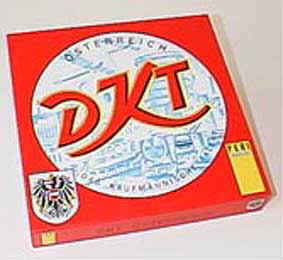 Edition: DKT
Österreich, PPG-ID: 18021 Edition: DKT
Österreich, PPG-ID: 18021
Publisher: Stome Spiele/PPGmbH/Peri-Spiele - 2000
Dimensions of the box: 25 x 25 x 4 cm
The game:
Since 1955 hardly anything has been changed in the design of this edition,
except for a bit more modern presentation, at least as far
as we can conclude from what the cover shows.
DKT warned on their website that "because of a technical mistake, which
unfortunately was discovered too late in some of the DKT games are wrong
property cards. For example the rent of the Kärntnerstraße with 1 house is 19,500.-
which have to be 1,950.-.
Should you be one of the unlucky person who bought such a set
you can contact
publisher."
Well, I think a collector will call him/herself a lucky person
rather than an unlucky one.
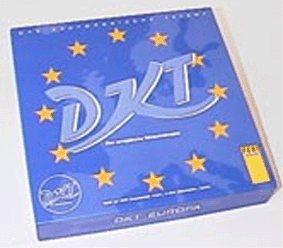 Edition: DKT
Europa, PPG-ID: 18022 Edition: DKT
Europa, PPG-ID: 18022
Publisher: Stome Spiele/Perner Prod.GmbH/Peri-Spiele - 2000
Dimensions of the box: 25 x 25 x 4 cm
The game:
Unfortunately I can only assume the properties of this edition concern European cities
(or countries?).
At least the picture of the box gives an impression of the edition.
I would appreciate an owner of this edition could provide me with more details
to insert
in this chapter.
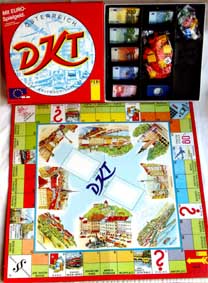 Edition:
DKT Österreich - Euro, PPG-ID: 18023 Edition:
DKT Österreich - Euro, PPG-ID: 18023
"Mit Euro-Spielgeld - © EWI MCMXCVII - Alle Rechte
vorbehalten"
Publisher: Stome Spiele/Perner Prod.GmbH/Peri-Spiele - 2000
Dimensions of the box: 25.2 x 25.2 cm
The game:
This set is owned by Brigitte Schwarzmann, proprietor of Haus
Alpenblick - Schröcken - Austria, where the guests can play
this
monopoly game.
Although the year 1997 is mentioned in the Ewi copyright reference, it is to believe that this issue is of some years later.
Like all modern issues from Peri-Spiele the box
is in red as the back side of the soft game
board is. This red back shows a pattern of
white lines and DKT.
Typical for this issue are of course the € banknotes (31x75 mm), even
for the slightly smaller one-euro (31x61 mm). Except for the € 1 all banknotes
are copies of the real money. Over start (the yellow
arrow) you receive € 200.
This edition appears to be a cheap issue because all property deeds
as well as the Bank- and Risiko cards are on sheets from
which they have to be separated before use. The innerbox contains a
"banker's tray" of thin, black plastic with 10 holes. The red
houses and yellow
hotels have overhanging roofs and are made of dull plastic. The 6 plastic
tokens are cylinders-with-a-ball-on-top.
The dice are white with black pips.
The Rules are both on a sheet as well printed on the bottom.
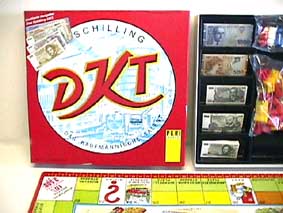 Edition:
Schilling - DKT, PPG-ID: 18026 Edition:
Schilling - DKT, PPG-ID: 18026
Publisher: Stome Spiele/Perner Prod.GmbH/Peri-Spiele - 2000
Dimensions of the box: 25.2 x 25.2 cm
The game:
The Rules start to say: "Seit mehr als zwei Generationen wird das
österreichische Wirtschaftsspiel DKT gespielt." (Since more
than 2 generations this Austrian business game DKT is played). This means
that this monopoly-like game with the streets from 8
cities already exsist for
about 50 years during which period only minor changes took place, like the Chance cards
changed
into Risiko
and the Sparkassa into Bank cards. Recently
the currency had to be changed into the Euro, the new money in
most
European countries.
This obviously was a good reason for Peri-Spiele to intoduce this limited
edition of 10,000 copies for the last time (?) in the
old currency Schilling.
Over Start you receive 2,000.- S.
The money consist of 5 banknotes (small copies of the former real
notes, all having different sizes, from 30x61 mm for the 20S note to 36x76
mm for the 1000S) and grey plastic coins
of dia. 17 mm for the 10S.
A red rim wih yellow
figures 1 to 40, known from earlier issues, is along side 3
of the game board.
This is to count the number of rounds played, however, there is no pawn added to this
game to place next to the figures.
The back side of the property cards (60x80 mm) is blue
with DKT-pattern, those of the Risiko cards are red
and of the Bank are beige with DKT-pattern.
The innerbox contains a "banker's tray" of thin, black plastic
with 10 holes. The red houses and yellow
hotels have overhanging roofs and are made of dull plastic. The 6 plastic
pawns are cylinders-with-a-ball-on-top. The dice are beige
with black
pips.
The Rules are both on a sheet as well printed on the bottom. There the Zertifikat
Nr. 00697/10.000 of this set is printed as well.
The price of this set amounted to € 28.60 March 2003.
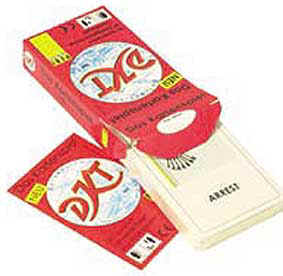 Edition: DKT Das Kartenspiel, PPG-ID: 18031
Edition: DKT Das Kartenspiel, PPG-ID: 18031
Publisher: Stome Spiele/Perner Prod.GmbH/Peri-Spiele - 2000
Dimensions of the box: 6 x 11,2 x 2 cm
The game:
Unfortunately I can only assume this game to be a Happy Families version of
DKT, which means it has to be
played a very different way. In that case the object is to collect Monopolies consisting of one of the well-known
street groups, the value of which to be increased by addition cards like
houses and hotels.
At least the picture of the box gives an impression of the edition.
I would appreciate an owner of this edition could provide me with more details
to insert
in this chapter.
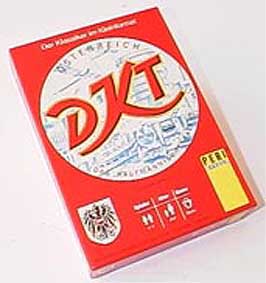 Edition: DKT
Österreich - Kleinspiel, PPG-ID: 19021 Edition: DKT
Österreich - Kleinspiel, PPG-ID: 19021
Publisher: Stome Spiele/Perner Prod.GmbH/Peri-Spiele - 2000
Dimensions of the box: 18 x 13 x 4 cm
The game:
Unfortunately I can only assume the properties of this edition to
concern the same
Austrian cities as of the PPD-ID:18026 version, because the difference is this
set to be a Kleinspiel (small issue).
At least the picture of the box gives an impression of the edition.
I would appreciate an owner of this edition could provide me with more details
to insert
in this chapter.
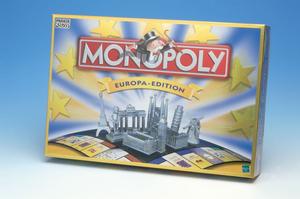 Edition:
Monopoly Europa Edition - German, Ref.Nr.
15283/100 Edition:
Monopoly Europa Edition - German, Ref.Nr.
15283/100
Publisher: Parker/Hasbro, Inc. - 2001
Dimensions of the box: 6.5 x 26.8 x 40.1 cm
The game:
After the edition with ref.nr. 05597 had been published it appeared the Hasbro designers did not know the capital of Switserland. They placed the important city Genf between the capitals of other European countries. However, it took 2 years until this new edition with new ref.nr. as well as a new
presentation (enlarged tokens on the lid and a banner with "Europa") was issued showing the
right Swiss capital Bern. All the rest of this game remained unchanged.
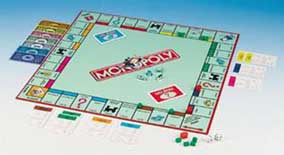 Edition: Standard, Ref.
00009/156 Edition: Standard, Ref.
00009/156
Publisher: Parker/Hasbro Inc. - 2001
Dimensions of the box: 26.8 x 40.3 x 5.3 cm
of the game board: 25.2 x 25.2 cm
The game:
Parker/Hasbro are standardizing their games
more and more world-wide (because of what to my opinion they become the less
interesting for collectors). Now the standard editions of all countries bear
number 9, the number for the American standard editions
since the first issues
of 1935.
The design of this new game features:
 | The illustration on the lid shows a somewhat cheap red
rim. |
 | Only 4 spaces of the fourth side of the game board are shown in perspective with 1 house, 1 hotel, still the hat and
the racecar as well as both dice, however now with 4 and 3
(instead of 3 and 5). |
 | The perspective red Monopoly bar with
the nice shadow and Mr.Monopoly with the red bow tie
(until 2000
he was Rich Uncle Pennybags), that appears on the lid, the
board game's midfield and all 4 rims of the innerbox. |
 | The bottom side of the box no longer shows "the laughing
family" but almost the whole game board with all its attrubutes. |
The "banker's tray" of this "standard"
box is red again and has holes
for 7 banknotes as well as for the property deeds who are still present with the banker.
The game board is folded in four and fits, when stored,
precisely on the banker's tray. The back of the board is as usual red,
the playside is blue green.
On the board the Ereignis cards with red
back in a lines pattern are as usual next to the Los corner and the Gemeinschafts
cards with blue back in a lines
pattern next to the Free Parking corner. The cards (56x87
mm) have round corners.
The property cards (56x87 mm) also have round corners.
The banknotes (52x100 mm) are printed on one side only. On top
of the circle on the note is a black ribbon showing "Monopoly with
Mr.Monopoly". At the bottom of this circle is in small characters "©2001 Hasbro
Inc.". The currency is Euro(€) and the denominations are
resp.: 1
- 5 -10
- 20 - 50
- 100 and 500
(ref.100 00009 00C0).
The 10 tokens are of light metal and are the well-known: hat -
shoe - car - boat - dog - wheelbarrow - rider-on-a-horse - thimble - iron and
canon.
The green houses
and red hotels
are of non-transparant plastic and have all an overhanging roof with an
excentric chimney.
Both dice are white with black pips.
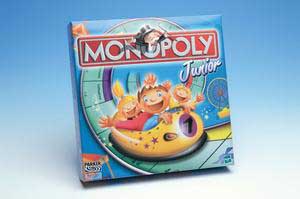 Edition:
Junior
standard - German, Ref.Nr. 00441/100 Edition:
Junior
standard - German, Ref.Nr. 00441/100
Publisher: Parker Bros./Hasbro - 2001
Dimensions of the box: 26.8 x 26.8 cm
The game:
Like they did for the 2001 standard edition Hasbro also decided to apply the American
reference number 441 for this new
Junior issue followed by the country
number. (The boring uniformity is consequently applied.)
The presentation on the lid of this
square box is absolutely dazzling indeed. A well streamlined cart
whirrling coming
down a twisted roller coaster. Did the red
cart of the 1996 edition show 4 kids now there are but 3 in a yellow
cart. It is also for the first time the red
Monopoly-bar-in-relief with Mr. Monopoly (as Uncle Pennybags is called since
2000) with red bow tie appears out the
central O. The Rules haven't of course been changed and
the oblong game board has been maintained as well. However, the currency
has ofcourse been changed into €uro.
|